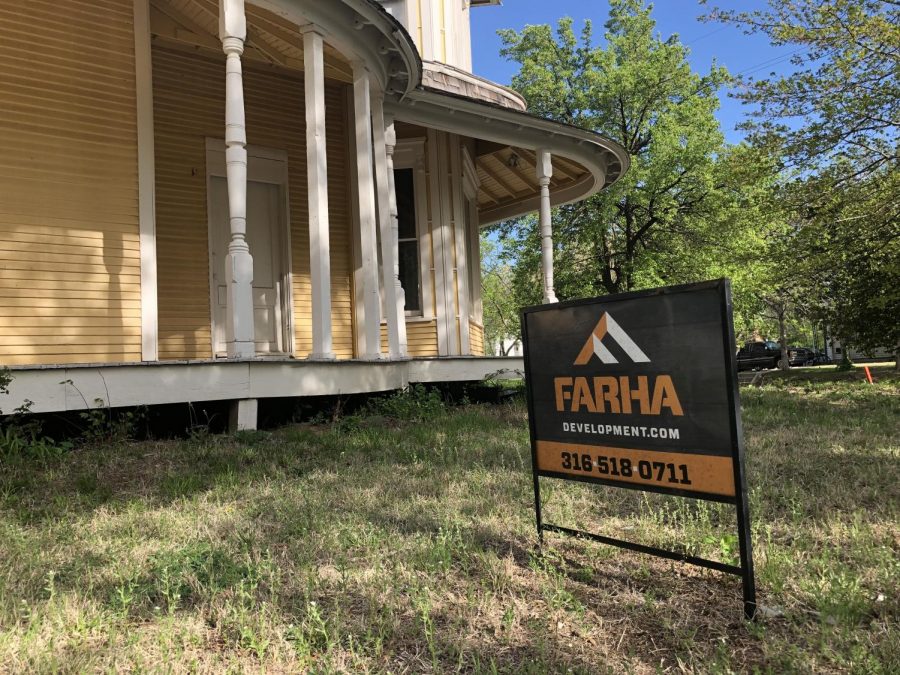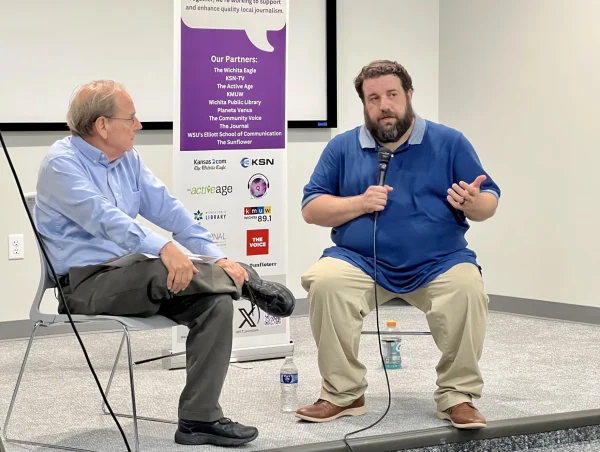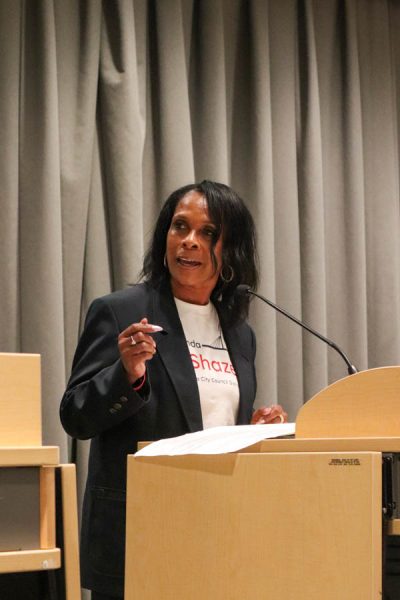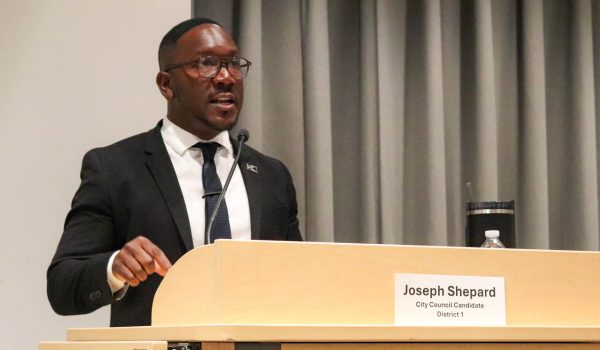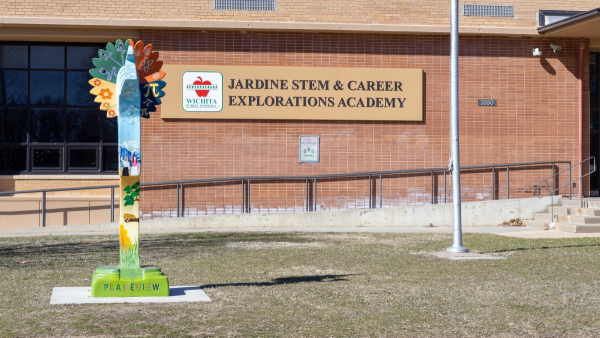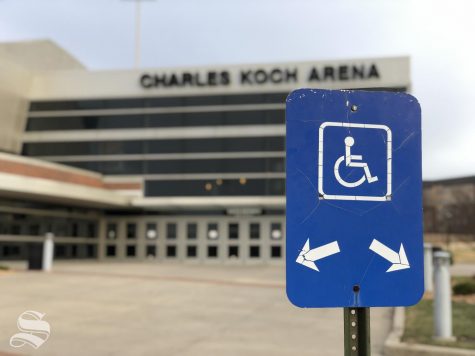As development ramps up, Fairmount stakeholders weigh in on community investment, gentrification
Holyoke Cottage was built in 1887 and later sold to Fairmount College as a women’s dorm. The cottage, which is on the National Registry of Historic Places, will soon house Storytime Village Literacy Center on its lower level. Upstairs will be dedicated to student housing. Farha Development owner Mark Farha and his partners have developed roughly 450 living spaces in the Fairmount neighborhood over the last decade. Many international students live in the rental housing and apartments.
Mark Farha’s vision of transforming Fairmount took root on a car ride through the neighborhood more than a decade ago, when the Farha Development owner saw a window of opportunity.
“About 13 years ago, we were driving through the neighborhood and thought, ‘Here’s a major university. Why isn’t there some more appealing, more attractive for-rent units in proximity to the school?’” Farha said in a March interview.
Farha Development’s first major renovation project in the community was the Granada Apartments, housed in a Spanish-style building on Fairmount Street that hadn’t been updated since it was built in the 1920s.
In the decade since the Granada, Farha and his partners have continued to develop property in the name of affordable student housing — renovating 450 living spaces in the Fairmount neighborhood.
Farha said he’s proud of the transformation and the roughly 400 students, most of them international, who live in his rental housing and apartments. He said many students can’t afford to live on campus.
“I’m trying like hell to do as much as we can to improve the area. Not all of the houses can stay.” — Mark Farha, Farha Development owner
This fall, Wichita State will open the Suites, phase two of the Flats private apartment complex. In July 2017, with the Flats below 20% occupancy, WSU shuttered university-owned Fairmount Towers residence hall and relocated students to the private facility.
“It has just created one hell of an opportunity for me, because you’re pricing 80% of the kids out of the market by charging them what they’re charging them on campus,” Farha said.
His properties across 17th Street are a three-minute walk from the Rhatigan Student Center.
“The properties that we have immediately south of campus are half the distance that it is from the Flats or the Flats Phase 2 to the Rhatigan Center, and I’m going to be anywhere from 20-50% less to rent,” Farha said.
Harjinder Singh graduated from WSU last fall with a master’s degree in aerospace engineering and is currently working on campus at the National Institute for Aviation Research. Originally from India, Singh has spent the last two and a half years living in rental housing on 17th Street.
He said affordability was his main concern when it came to making living arrangements.
“It’s expensive on campus,” Singh said. “I can live off campus spending less than half of the money.”
He said he also appreciates the privacy of living off campus.
Farha, a former vice president of the Fairmount Neighborhood Association, said that beyond providing affordable housing, his company has helped with neighborhood cleanups — building fences and painting houses that haven’t had a fresh coat in 20 years.
“In the near future, it will be quite apparent to about anyone driving down 17th Street that the south of campus has made some major, major changes,” Farha said.
Gentrification
Brandon Johnson, District 1 city councilman for just over a year, said he knocked on every door in the Fairmount neighborhood during his 2017 campaign.
Johnson said Fairmount residents generally have a positive relationship with WSU — save for their streets being perpetually jammed with students’ parked cars. He said there’s more skepticism when it comes to the developers profiting off of the neighborhood’s proximity to campus.
“What I hear are fears of expansion from Wichita State, which truly means, since it’s not Wichita State doing it, the fears of developers changing 17th Street drastically enough to change property values and push people out,” Johnson said.
“Those fears need to be addressed so that someone who’s 85, who wants to — and it sounds a little morbid — but who wants to die in that house, is not pushed out because they can’t afford it.”
In an April interview, Farha rebuffed Johnson’s claim that development could force elderly Fairmount residents out of their homes against their will.
“Currently, I don’t have a single 85-year-old who wants to die in their house,” Farha said.
“If they don’t sell their property, they don’t sell their property. I don’t have eminent domain. I can’t force people out of their homes — nor do I want to.”
“There’s excitement about what can come. There’s just a fear of what that means, and that fear has not been addressed.” — Brandon Johnson, District 1 city councilman
Debbie McGuire spends most of her time in Fairmount caring for her 99-year-old father in his home on Harvard Street, just across 17th Street from the university. McGuire said that in recent years, student housing development has led to fewer lifelong residents calling the block home.
“We’ve been contacted by development people that I’m sure want to just raze the home and maybe do the lot next to us,” McGuire said.
“I don’t know if they want to do apartments or what, but it’s normal that when you’ve got a college, you’ve got to have space for students too.”
McGuire said she likes being so close to the university.
“We love seeing the kids — we don’t get to know them very long because they’re kind of in and out,” she said.
“I would hate to see this whole neighborhood be high-rise apartments or something, but it may happen.”
Farha said that although most new development is student-oriented, lifelong residents shouldn’t be threatened by his presence in the neighborhood.
“Off-campus housing — that’s my main focus, absolutely,” Farha said. “But I’m not trying to run anyone out of the neighborhood.
“I just want to make good student housing available and have a safe community.”
Farha said he loves Fairmount and sees his work as community investment.
“I’m trying like hell to do as much as we can to improve the area,” Farha said. “Not all of the houses can stay.”
He said when he and his partners restore properties, it prompts other community members to “elevate their game and clean up their neighborhood — take care of their properties.”
“You got your heart and soul invested in, you know, beautifying and taking care of a neighborhood and making it nicer all the time,” Farha said. “I can’t tell you how many times I’ve stopped to pick up trash or clean something up.”
Cruising around Fairmount development sites in his white pickup truck last week, Farha paused his interview with The Sunflower intermittently to pick up chunks of concrete and throw them into the bed of his truck.
Councilman Johnson said there’s an important distinction to draw between gentrification and community development.
“Development is finding ways to include the community — take into consideration that this here could increase your property values or the value of the community, so what we’re going to do to minimize you moving out is we’ll find you somewhere to work in here.”
Farha said the Fairmount Neighborhood Association supports his mission of community investment.
“I think the Fairmount Neighborhood Association is and has probably been our strongest ally in our efforts to improve the neighborhood,” Farha said.
“I really think that WSU is a great asset to the neighborhood, and if it takes part of the neighborhood with it, that’s just part of it.” — Ed Langston, Fairmount resident
Vivien Minshull-Ford, current vice president of the neighborhood association, said housing prices haven’t been noticeably affected by continued development in the area.
“The housing prices are quite low, and have sort of gone down if anything, which is very sad,” Minshull-Ford said.
She said displacement hasn’t been a major issue either.
“A couple people were very nervous that they were going to be turned out of their houses so that they could be upgraded,” Minshull-Ford said. “Well, a lot of these things haven’t really happened.”
Darryl Carrington, a WSU graduate and the university’s former Fairmount community liaison, said Johnson may have his “finger on the pulse in terms of a much broader constituency,” but the councilman doesn’t speak for the Fairmount community when it comes to perceived concerns of displacement.
“I think Brandon (Johnson) misses the mark on that for sure,” Carrington said.
Johnson noted that some residents might be hesitant to voice their concerns about development.
“There’s also fear of saying that too loud, because what if that scares a developer away?” Johnson said.
“I don’t want to make it sound like 80% of people hate this — there’s excitement about what can come. There’s just a fear of what that means, and that fear has not been addressed.”
Ed Langston, who has lived in his house on Vassar Street since 1981, said he has “mixed feelings” about continued development in the community.
He said WSU has plenty of space to build on Innovation Campus for now, but the Fairmount neighborhood will likely be the next frontier for campus expansion.
“Gentrification is sort of an issue that — it concerns me a little bit, but in 20 years, this property right here will probably belong to WSU, and that’s fine with me,” Langston said.
“I really think that WSU is a great asset to the neighborhood, and if it takes part of the neighborhood with it, that’s just part of it. Twenty years from now, I’ll be gone anyways.”
Farha doesn’t shy away from acknowledging that gentrification is a side effect of development.
“There’s only so much land adjacent to Wichita State. Wichita State as a school and the student body benefits greatly from me investing into and improving the adjacent neighborhood,” Farha said.
“If that’s called gentrification, then it is.”
That means a certain level of displacement.
“If I scrape 30 houses and build a student housing complex with 350 bedrooms for students, you are displacing some people. But what did you pay them for their property?” Farha said. “You probably paid them an absolutely astronomical amount of money that they normally would not ever have an opportunity to get.
“If I told you the prices that I’ve paid people for properties in this area, you’d think I’m crazy.”
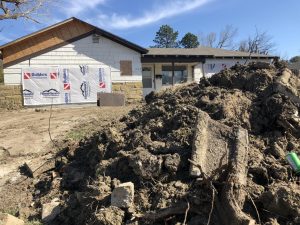
A dilapidated house stands at 1544 Matlock in the Fairmount neighborhood. A sign on the window notes that it is in violation of a housing ordinance.
Carrington said residents afraid of potentially rising property values need to realize that their houses are being devalued. He said he bought his home in Fairmount without using a bank.
“That’s how depressed those property values are,” Carrington said.
He said home ownership is an investment that should help residents pass wealth from generation to generation.
“People need to realize their investment,” he said.
Community Investment
Carrington said gentrification is a sensitive topic, and that the word itself has negative connotations he doesn’t associate with development taking place in Fairmount.
“The ‘G’ word, ‘gentrification’ — everybody’s afraid of it because usually when we hear about it, it’s detrimental to somebody, but in this case, there’s another phrase called ‘development in place,’” Carrington said.
To explain the phenomenon, Carrington described a scenario where WSU employees move into an improved Fairmount neighborhood and incite positive change.
“What it would do instantly is change the dynamics in that all of a sudden, I have someone in my neighborhood that’s a professional,” Carrington said. “Let’s just say they’re a professor on campus or an administrator on campus. Now, all of a sudden, I feel like I have an inside track.
“I can go to someone and say, ‘How do I get myself, my spouse, my kids — how do we get on campus?’”
Minshull-Ford has lived in Fairmount with her husband, WSU philosophy professor Robert Feleppa, since the mid-1980s. There used to be quite a few faculty members living in Fairmount, but that isn’t the case anymore, she said.
Minshull-Ford said WSU should expose children in the community to higher education and the resources available at the university.
“All these kids are over the road from a university, and that road, 17th Street, is as deep as the Grand Canyon,” Minshull-Ford said. “Where there were possibilities that they could gain something, or there would be programs that could affect their lives and give them opportunities they hadn’t had before.
“Some of that GoCreate, the Innovation Campus, is supposed to be geared for the community as much as for the campus, and I’m not sure whether that’s still actually happening,” Minshull-Ford said.
Lavonta Williams, who represented District 1 on the City Council before Johnson, told the Chung Report last year that WSU is a place where community members feel welcome.
“It is a place where our young people who are surrounding this community now feel like they can go to campus here,” Williams said. “They can come onto the WSU campus and go to school, where many thought before that they could not come.”
Minshull-Ford said that during the Enough is Enough campaign, Fairmount residents toured Innovation Campus.
“Busloads of us went on tours of campus to see some of that innovation stuff. You know, all the things that are electronic — imaging and all of those things, but where Fairmount neighborhood comes into that, I never really quite knew,” Minshull-Ford said.
“All these kids are over the road from a university, and that road, 17th Street, is as deep as the Grand Canyon.” — Vivien Minshull-Ford, Fairmount Neighborhood Association vice president
She said the community could benefit greatly from an after-school children’s program. Fairmount used to have such a program — Fairmount Go Zones! — which provided games, tutoring, and occasional field trips for children.
The program was held in the education building adjacent to the Fairmount United Church of Christ, but that space was lost when the church sold the property to developers who plan to convert it to student housing.
Minshull-Ford said she wished the Enough is Enough campaign, which addressed such concerns as lighting in Fairmount Park, had longer-lasting effects on the neighborhood.
“You think, my God, what happened to that? Did we just get lighting out of it?” Minshull-Ford said.
Carrington said certain investments are being made to enhance life for Fairmount residents.
This summer, Farha Development will break ground on Storytime Village Literacy Center, which will promote child literacy in the neighborhood. The literacy center will be located in Holyoke Cottage, which was built in 1887 and later sold to Fairmount College as a women’s dorm.
The first floor of the cottage, which is on the National Register of Historic Places, will house Storytime Village. Upstairs will be dedicated to student housing, Farha said.
He said everyone in the community stands to gain from his development.
“Building fences and painting houses and remodeling homes and making them nicer — building and providing housing for students and families — if there’s something wrong with that, then what I’m doing is truly wrong,” Farha said.

Matthew Kelly is a former editor-in-chief and managing editor for The Sunflower. Kelly graduated in 2020 with a bachelor’s degree in political science...



